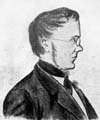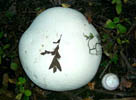
Trivia


Top Ten
 Trivia |  |  Top Ten |
|

A. vernus, cap slightly scaly, margin smooth; stem stuffed, more or less equal; volva free, saccate
White, odor unpleasant. Stem 3-6 unc. long, 4 lin. wide, splitting at the ends. Cap ovate when young, becoming smooth and somewhat depressed, the margin becoming somewhat wavy and uplifted, 2 4 unc. Wide. Gills lanceolate.
In woods, solitary in humus, frequent. Spring and summer.
6. Am. Vénéneuse
Am. virosa
Var. A - - Bulliard, pl. 577, fig. H. A. bulbeux?
Bolton Hist. Fung. tabl. 48 A. vernalis. Pileo glutinoso
|

Var. B - - It grows under first; the dimensions are all larger. The cap is covered with a few small warts. In the same season. (As found in Landoup)
Observations:To me it seems that this is a separate species, which one distinguishes from Amanita verna essentially by the attached gills, and from Amanita bulbosa by the thickness of its stalk, by its greater diameter; and, in both cases, by the patches on the stalk and the viscosity of the cap.
|

|

 Glossary |  Mushrooms |  |  People |  Newsletter |  Events |